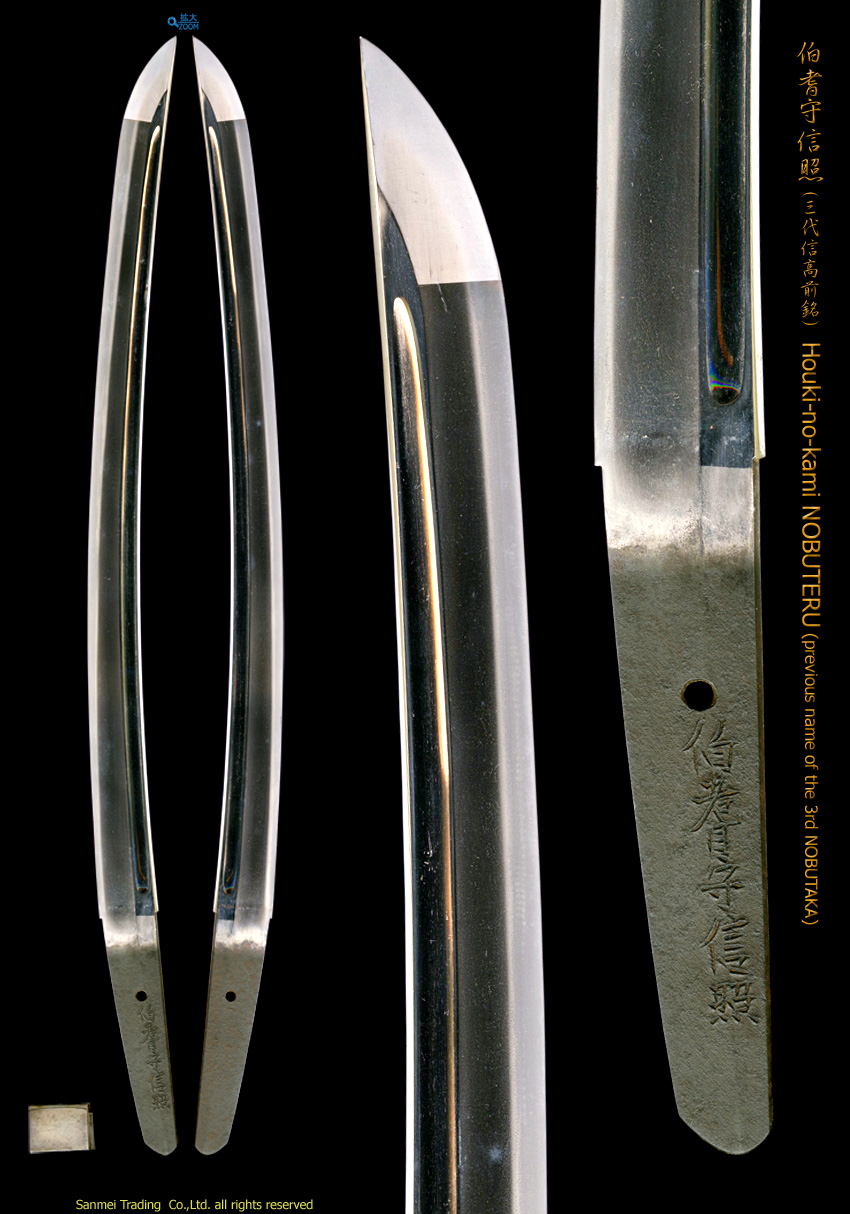Length of cutting edge 54.7cm Curvature 1.8cm Width of base 37.0mm Width of Yokote27.4mm Thickness of base 8.5mm
Carving: Bo-hi grooves on both sides, of which tip ends lower at Yokote level.
Forging(Hada): Forging mark is based on fine Mokume wooden grain using steel of superfine quality with the impression of bluish steel. Hiraji surface is covered with sparkling Nie glitter so called Ji-nie crystallized particles to generate darkish Mokume patterns of Chikei activity.
Temper(Hamon): Hamon is wide Suguha with minute irregular pattern Komidare. Boundary line is covered with a bit on coarser side Nie where is active with Ni-ju-ha or Hotsure. Sparkling Nie glitter accumulates thickly along temper line whereas the interior of temper it is full of crystallized misty Nioi with rich activity of frequent minute Ko-Ashi feet and floating YOU activates.
Temper of tip(Boshi): Boshi is straight with minute irregular pattern, medium circle turns back deeply to the back ridge.
Tang(Nakago): UBU in original, One retaining peg hole. Greatly slanting left filemarks. Uneven U-shape bottom heel in full. Round back ridge with greatly slanting left filemarks. The signature in front starts with an official district title Houki-no-kami 伯耆守 and smith name NOBUTERU 信照.
NOBUTERU 信照 is the previous name before his official succession of the headship famed NOBUTAKA 信高. This Wakizashi singed NOBUTERU 信照 (NOBUTAKA 3rd 信高) is extremely stout with extraordinary wide in Mihaba and very thick in Kasane, quite heavy on hand. This powerful blade construction was created under the Samuri spirit fostered by the most powerful Bushido master Yagyu Renya Shigekane (1625-1694) 柳生連也厳包. Admired as Ōwaza-mono (the best cutting performance)
This is understood that this Wakizashi was made in a few month short period of time - on after Houki-no-kami title 伯耆守 obtained in the 5th day, the 3rd month, Kanbun 5 (1665) but made before succession of the heaadship of NOBUTAKA 信高 in the 5th month the same year of Kanbun 5 (1665) on the occasion to become an official maker with a stipend for 10 persons by Tokugawa Mitsutomo 徳川光友. It is quite rare to find the works of NOBUTERU 信照 to add historical value.
This is a typical example of work which had been owed and treasured by Owari Samurais holding brave spirit and it is understood that smith NOBUTAKA 3rd was particularly skilled to meet with their requirement. Nakago holds a good taste of patina, remains clear filemark and chisel of signature.
In reference to the other wakizashi signed [San-ami Mappa Houki-no-kami Nobutaka saku, Owned by Taira-uji Shigekane, Kanbun 7, Autumn, Cut a Ichino-dou body with thigh at once, Two bellies cut through at once over a few SUN down into the ground] possessed by The Kuwana City Museum 脇指 『三阿弥末派伯耆守信高作 平氏厳包所持之、寛文七秋一之胴奥大桃灯一刃 二津胴快裁落之入平地数寸也』.
During Kanbun/Enpo period in the middle of 17th century, there was large demand of swords from Samurais, who preferred stout and best cutting performing blades especially in Owari where Bushido was remarkably vigorous. The smith Nobutaka proudly worked for a Bushido instructor of Owari Tokugawa, Yagyu Renya Shigekane(1625-1694) 柳生連也厳包 and have been prized by Owari Samurais from long ago for their cutting ability as Owaza-mono (the best cutting performance).
The 2nd generation NOBUTAKA was born in Keicho 8, (1603) as a legitimate child of 1st generation NOBUTAKA 慶遊信高 in Seki-kaji town Kiyosu Owari domain. He had moved to Seki-Kaji town Nagoya (now in Marunouchi 3 chome, Naka-ku, Nagoya) in Nagoya castle relocation , the 2nd month, Keicho 15 (1610). He obtained official district title "Hōki-no-kami" , in the 29th day, 8th month, Kanei 10 (1633) at 31 years old then had exclusively worked for Tokugawa Yoshinao 徳川義直 and the vassals of the Owari Tokugawas with as much as a one hundred koku stipend.
He once announced his retirement in Kanbun 2, at 60 years old in order to abdicate in favor of his son officially but he still remained to the stage with the additionally signed monk name [Nyudō入道] at the end of his signature or add [Zenpakushu 前伯州] title on top. Passed away in the 27th day, 9th month, the 2th year of Genroku (1689), 87 years old.
The subject maker of this Wakizashi - 3rd generation NOBUTAKA信高, Kawamura San-no-sho NOBUTAKA, who was born in the ninth year of Kanei (1632) in Nagoya, Owari, enjoyed Hōki-no-kami title when he was 34 years old at the fifth day, third month, the fifth year of Kanbun (1665).
Also he was nominated in the fifth month, the same year, to work for the domain of Owari Tokugawa exclusively by the second feudal lord Tokugawa Mitsutomo 徳川光友.
Silver foiled single layer Habaki collar, Preserved in an old Shira-Saya plain wood mounting.
Old good polish/Condition scale: excellent-very good (using a scale of mint-excellent-very good-good-fair-poor).
reference data:
Iwata Atou Owari Tōkōfu 1985 Publisher : Nagoya city Board of Education
Kato Hiroshi Token Bijutsu vol.357 1986 Japan Sword Preservation Society
Wakizashi signed [San-ami Mappa Houki-no-kami Nobutaka saku, Owned by Taira-uji Shigekane, kanbun 7, Autumn, Cut a Ichino-dou body and thigh at once, Two bellys cut through at once over a few SUN down into the ground] possesed by The Kuwana City Museum 脇指 『三阿弥末派伯耆守信高作 平氏厳包所持之、寛文七秋一之胴奥大桃灯一刃 二津胴快裁落之入平地数寸也』.


